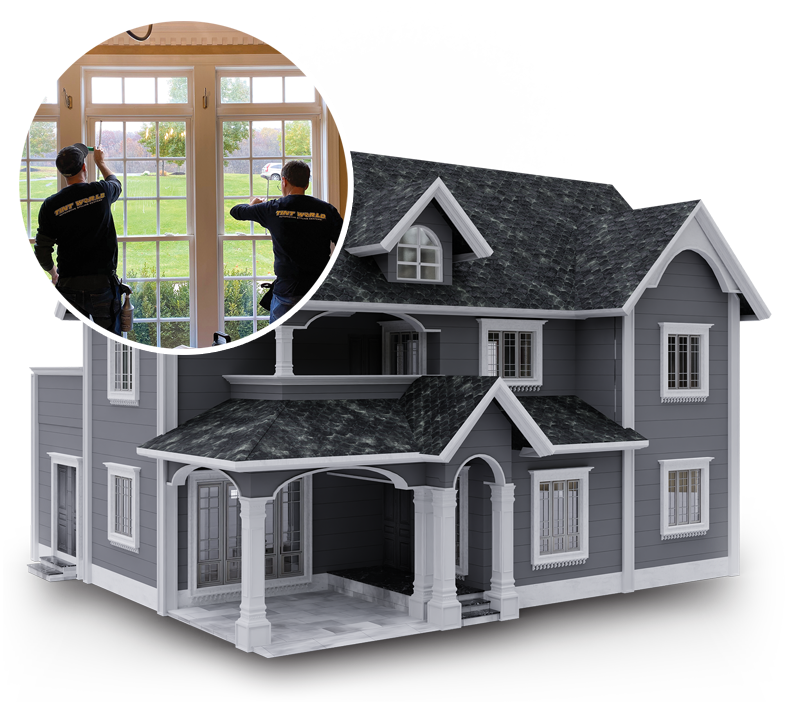Just How Residential Window Tint Can Decrease Power Bills
Just How Residential Window Tint Can Decrease Power Bills
Blog Article
Just How Residential Home Window Tinting Improves Your Home's Energy Efficiency
Residential home window tinting offers a compelling service for home owners seeking to improve power performance within their living spaces. By applying specialized films to home windows, it effectively decreases warmth transfer, thereby supporting indoor temperature levels and decreasing the demand for too much heating or cooling.
Comprehending Home Window Tinting
Recognizing home window tinting is important for property owners seeking to improve both convenience and power performance in their home. Residential Window Tint. Window tinting includes the application of a thin film to the interior or exterior surface area of glass home windows. This movie can considerably modulate the amount of sunshine and warm that gets in a home, therefore influencing indoor climate problems
There are various kinds of window tinting movies available, each with distinct residential or commercial properties. The efficiency of window tinting is typically measured by its Visible Light Transmission (VLT) percentage, which shows how much light can pass through the movie.
Benefits of Power Effectiveness
Window tinting not just enhances aesthetic appeals however also plays a substantial role in boosting energy effectiveness within household areas. By lowering warm transfer via home windows, colored films produce an extra steady indoor climate, which can bring about significant decreases in energy usage for heating and air conditioning. This energy effectiveness converts into reduced utility expenses, giving property owners with significant long-term cost savings.

Additionally, home window tinting improves the comfort of living spaces. By decreasing glow and blocking harmful UV rays, tinted windows develop a more pleasant setting, which can cause boosted health for passengers. The protection versus UV rays also aids preserve furnishings and flooring from fading, adding to the durability of household products.
Just How Tinting Functions
Tinting movies run via a mix of advanced materials and technologies made to manage the quantity of solar energy getting in a home. Mostly made up of polyester, these films often include ceramic or metallic bits that mirror and take in warm. This twin capability allows them to dramatically lower the penetration of ultraviolet (UV) rays and infrared radiation while allowing noticeable light to go through.
The efficiency of window tinting is gauged by its solar warmth gain coefficient (SHGC), which shows how much solar power is sent through the window. Lower SHGC worths are more suitable as they signify better heat denial. Additionally, window colors can include a variety of shades, enabling homeowners to personalize their visual choices while boosting energy performance.
Moreover, these movies work as an obstacle, preventing warm loss throughout chillier months by showing indoor heat back right into the living space. This thermal insulation result complements the cooling benefits acquired during warmer months, adding to a well balanced interior environment year-round. By managing solar power effectively, property home window tinting not just boosts convenience yet additionally plays a vital function in minimizing energy usage and reducing utility expenses.
Selecting the Right Color

There are numerous kinds of window films offered, consisting of dyed, metalized, and ceramic. Colored films are economical but might have restricted durability. Metalized movies supply far better warmth rejection however can conflict with electronic signals. Ceramic movies offer superb warmth control without endangering visibility and are highly long lasting, making them a prominent choice.
Noticeable light wikipedia reference transmission (VLT) is one more essential element, as it indicates the amount of natural light that can pass through the tinted glass. House owners should select a tint with a VLT that matches their illumination preferences while still supplying ample her explanation glow reduction.
Furthermore, assessing the solar warmth gain coefficient (SHGC) can assist establish how well a tint can obstruct heat from sunlight. A reduced SHGC suggests far better warm control, ultimately boosting power effectiveness.
Setup and Maintenance Tips
Appropriate setup and upkeep are important components in taking full advantage of the advantages of residential window tinting. To attain optimal results, it is suggested to hire a qualified professional for setup. This ensures that the color is applied appropriately, avoiding air bubbles, wrinkles, or misalignment that could jeopardize performance. Experts additionally make use of specialized methods and devices, which can enhance the toughness and efficiency of the color.
Following setup, maintenance is crucial to lengthen the life of the window movie. It is advised to wait at least 30 days before cleansing the tinted windows to allow the sticky to treat completely.
Additionally, routine examinations are advantageous. Look for any kind of peeling or bubbling, which might indicate improper setup or put on gradually - Residential Window Tint. Dealing with these concerns without delay can protect against more damages and keep energy performance. By adhering to these setup and maintenance tips, house owners can guarantee their home window tinting remains to supply significant power cost savings and comfort for many years ahead.
Final Thought
In conclusion, property Source home window tinting serves as a reliable solution for improving power effectiveness within homes. By lowering heat transfer and obstructing harmful UV rays, window movies contribute to reduce power intake and improved interior convenience.
Window tinting includes the application of a slim movie to the interior or exterior surface area of glass home windows. By reducing warm transfer with home windows, colored films produce an extra secure indoor climate, which can lead to substantial reductions in energy usage for home heating and cooling.The efficiency of home window tinting is gauged by its solar warm gain coefficient (SHGC), which shows how much solar energy is transferred via the home window. By managing solar energy efficiently, property home window tinting not only enhances comfort but also plays a crucial duty in lowering power intake and lowering utility costs.
By reducing heat transfer and blocking harmful UV rays, window films contribute to lower energy consumption and improved indoor convenience.
Report this page